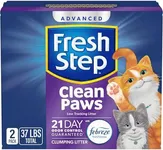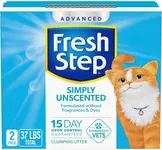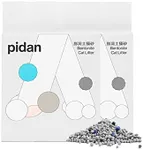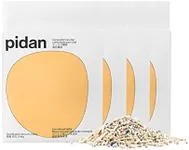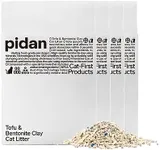Buying Guide for the Best Cat Litter Uk
Choosing the right cat litter is essential for both your cat's comfort and your convenience. The right litter can help control odors, reduce mess, and make cleaning easier. When selecting cat litter, consider your cat's preferences, any allergies or sensitivities, and the specific needs of your household. Here are some key specifications to consider when choosing cat litter.MaterialCat litter comes in various materials such as clay, silica gel, recycled paper, and natural/biodegradable options like wood, corn, or wheat. The material affects absorbency, odor control, and dust levels. Clay is highly absorbent and good for odor control but can be dusty. Silica gel is low-dust and long-lasting but can be more expensive. Natural options are eco-friendly and often less dusty but may not control odors as well. Choose a material based on your cat's preferences and any health concerns, such as respiratory issues or allergies.
Clumping vs. Non-ClumpingClumping litter forms solid clumps when wet, making it easier to scoop out waste and keep the litter box clean. Non-clumping litter absorbs moisture but doesn't form clumps, so the entire box needs to be changed more frequently. Clumping litter is generally more convenient for daily maintenance, while non-clumping may be better for cats with certain health issues or for owners who prefer a simpler, less expensive option. Consider how often you want to clean the litter box and your cat's habits when choosing between clumping and non-clumping.
Odor ControlOdor control is crucial for maintaining a pleasant-smelling home. Some litters have added fragrances or baking soda to help mask odors, while others rely on the natural odor-absorbing properties of the material. If you or your cat are sensitive to fragrances, opt for an unscented litter with good natural odor control. For households with multiple cats or strong-smelling waste, a litter with enhanced odor control features may be necessary. Evaluate your tolerance for odors and your cat's reaction to scented products when making your choice.
Dust LevelsDust levels in cat litter can affect both your cat's health and the cleanliness of your home. High-dust litters can cause respiratory issues for both cats and humans, especially those with allergies or asthma. Low-dust or dust-free litters are better for maintaining air quality and reducing the amount of dust tracked around the house. If dust is a concern, look for litters labeled as low-dust or dust-free, and consider the material, as some are naturally less dusty than others.
TrackingTracking refers to how much litter gets stuck to your cat's paws and is carried out of the litter box. High-tracking litters can create a mess around your home, while low-tracking litters help keep the area cleaner. Factors that affect tracking include the size and shape of the litter granules and the material. Larger granules and certain materials like silica gel tend to track less. If you want to minimize mess, choose a low-tracking litter and consider using a litter mat to catch any stray particles.
AbsorbencyAbsorbency is the litter's ability to soak up moisture and control urine. Highly absorbent litters help keep the litter box dry and reduce odors. Clay and silica gel litters are known for their high absorbency, while some natural litters may vary. If you have a single cat, a moderately absorbent litter may suffice, but for multiple cats or heavy urinators, a highly absorbent litter is essential to maintain a clean and odor-free environment.
Eco-FriendlinessEco-friendliness refers to the environmental impact of the litter. Natural and biodegradable litters made from materials like wood, corn, or wheat are more sustainable and can be composted. Clay and silica gel litters are less eco-friendly due to their mining and production processes. If environmental impact is important to you, opt for a natural, biodegradable litter. Consider how the litter is sourced, produced, and disposed of when evaluating its eco-friendliness.


